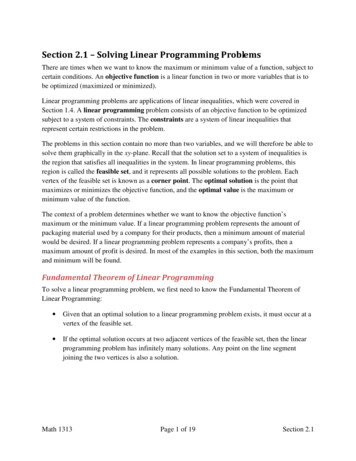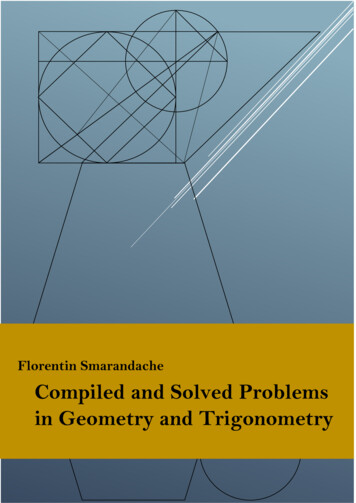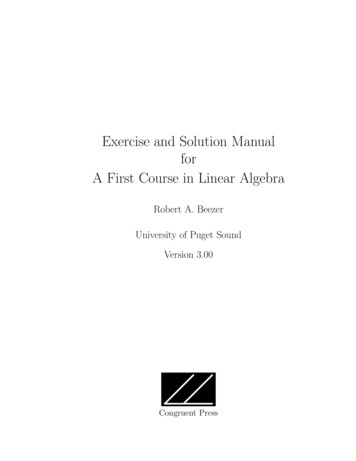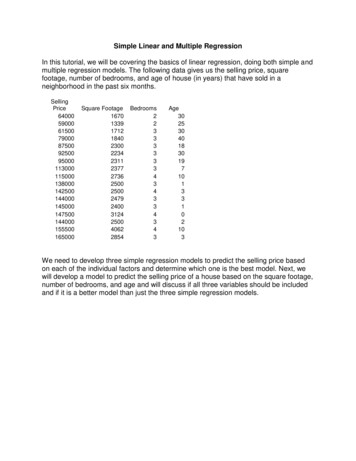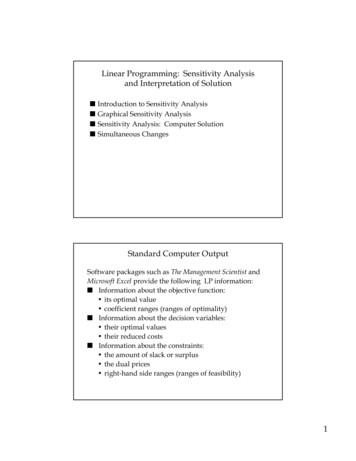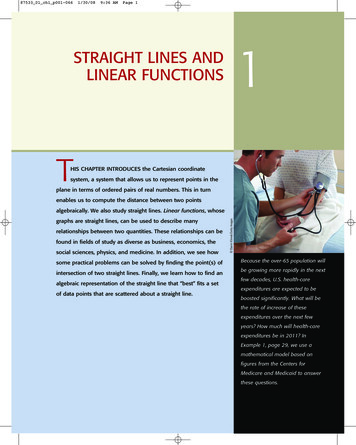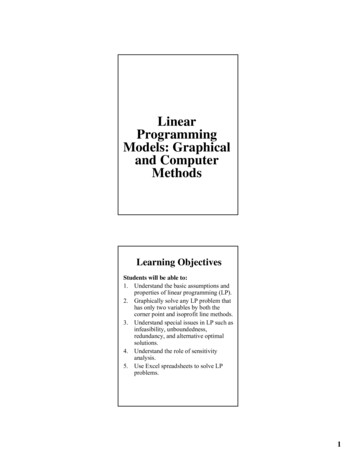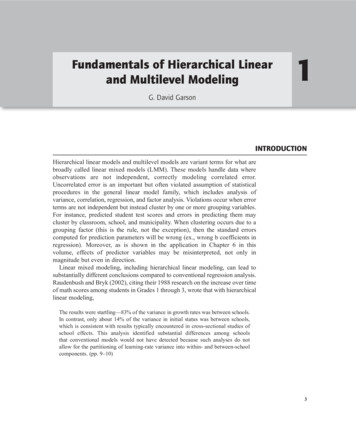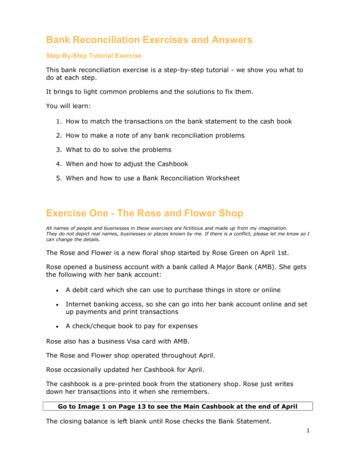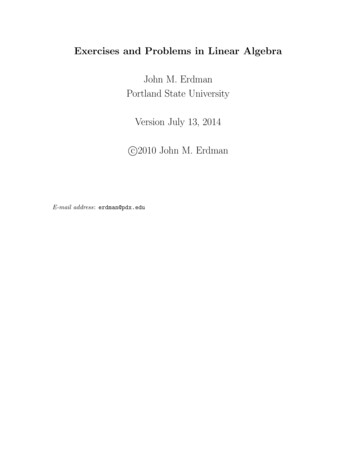
Transcription
Exercises and Problems in Linear AlgebraJohn M. ErdmanPortland State UniversityVersion July 13, 2014c 2010 John M. ErdmanE-mail address: erdman@pdx.edu
ContentsPREFACEPart 1.viiMATRICES AND LINEAR EQUATIONSChapter 1. SYSTEMS OF LINEAR EQUATIONS1.1. Background1.2. Exercises1.3. Problems1.4. Answers to Odd-Numbered Exercises133478Chapter 2. ARITHMETIC OF MATRICES2.1. Background2.2. Exercises2.3. Problems2.4. Answers to Odd-Numbered Exercises99101214Chapter 3. ELEMENTARY MATRICES; DETERMINANTS3.1. Background3.2. Exercises3.3. Problems3.4. Answers to Odd-Numbered Exercises1515172223Chapter 4. VECTOR GEOMETRY IN Rn4.1. Background4.2. Exercises4.3. Problems4.4. Answers to Odd-Numbered Exercises2525262829Part 2.31VECTOR SPACESChapter 5. VECTOR SPACES5.1. Background5.2. Exercises5.3. Problems5.4. Answers to Odd-Numbered Exercises3333343738Chapter 6. SUBSPACES6.1. Background6.2. Exercises6.3. Problems6.4. Answers to Odd-Numbered Exercises3939404445Chapter 7. LINEAR INDEPENDENCE7.1. Background7.2. Exercises474749iii
ivCONTENTS7.3. Problems7.4. Answers to Odd-Numbered Exercises5153Chapter 8. BASIS FOR A VECTOR SPACE8.1. Background8.2. Exercises8.3. Problems8.4. Answers to Odd-Numbered Exercises5555565758Part 3.59LINEAR MAPS BETWEEN VECTOR SPACESChapter 9. LINEARITY9.1. Background9.2. Exercises9.3. Problems9.4. Answers to Odd-Numbered Exercises6161636770Chapter10.1.10.2.10.3.10.4.10. LINEAR MAPS BETWEEN EUCLIDEAN SPACESBackgroundExercisesProblemsAnswers to Odd-Numbered Exercises7171727475Chapter11.1.11.2.11.3.11.4.11. PROJECTION OPERATORSBackgroundExercisesProblemsAnswers to Odd-Numbered Exercises7777787980Part 4.SPECTRAL THEORY OF VECTOR SPACES81Chapter12.1.12.2.12.3.12.4.12. EIGENVALUES AND EIGENVECTORSBackgroundExercisesProblemsAnswers to Odd-Numbered Exercises8383848586Chapter13.1.13.2.13.3.13.4.13. DIAGONALIZATION OF MATRICESBackgroundExercisesProblemsAnswers to Odd-Numbered Exercises8787899192Chapter14.1.14.2.14.3.14. SPECTRAL THEOREM FOR VECTOR SPACESBackgroundExercisesAnswers to Odd-Numbered Exercises93939496Chapter15.1.15.2.15.3.15.4.15. SOME APPLICATIONS OF THE SPECTRAL THEOREMBackgroundExercisesProblemsAnswers to Odd-Numbered ExercisesChapter 16.EVERY OPERATOR IS DIAGONALIZABLE PLUS NILPOTENT979798102103105
CONTENTS16.1.16.2.16.3.16.4.Part 5.BackgroundExercisesProblemsAnswers to Odd-Numbered ExercisesTHE GEOMETRY OF INNER PRODUCT 7. COMPLEX ARITHMETICBackgroundExercisesProblemsAnswers to Odd-Numbered .18. REAL AND COMPLEX INNER PRODUCT SPACESBackgroundExercisesProblemsAnswers to Odd-Numbered .19. ORTHONORMAL SETS OF VECTORSBackgroundExercisesProblemsAnswers to Odd-Numbered .20. QUADRATIC FORMSBackgroundExercisesProblemsAnswers to Odd-Numbered .21. OPTIMIZATIONBackgroundExercisesProblemsAnswers to Odd-Numbered Exercises139139140141142Part 6.ADJOINT OPERATORS143Chapter22.1.22.2.22.3.22.4.22. ADJOINTS AND TRANSPOSESBackgroundExercisesProblemsAnswers to Odd-Numbered .23. THE FOUR FUNDAMENTAL SUBSPACESBackgroundExercisesProblemsAnswers to Odd-Numbered Exercises149149151155157Chapter 24. ORTHOGONAL PROJECTIONS24.1. Background24.2. Exercises159159160
viCONTENTS24.3. Problems24.4. Answers to Odd-Numbered ExercisesChapter25.1.25.2.25.3.25.4.Part 7.25. LEAST SQUARES APPROXIMATIONBackgroundExercisesProblemsAnswers to Odd-Numbered ExercisesSPECTRAL THEORY OF INNER PRODUCT 3.26.4.26. SPECTRAL THEOREM FOR REAL INNER PRODUCT SPACESBackgroundExercisesProblemAnswers to the Odd-Numbered 27. SPECTRAL THEOREM FOR COMPLEX INNER PRODUCT SPACESBackgroundExercisesProblemsAnswers to Odd-Numbered Exercises177177178181182Bibliography183Index185
PREFACEThis collection of exercises is designed to provide a framework for discussion in a junior levellinear algebra class such as the one I have conducted fairly regularly at Portland State University.There is no assigned text. Students are free to choose their own sources of information. Students are encouraged to find books, papers, and web sites whose writing style they find congenial,whose emphasis matches their interests, and whose price fits their budgets. The short introductory background section in these exercises, which precede each assignment, are intended only to fixnotation and provide “official” definitions and statements of important theorems for the exercisesand problems which follow.There are a number of excellent online texts which are available free of charge. Among the bestare Linear Algebra [7] by Jim Hefferon,http://joshua.smcvt.edu/linearalgebraand A First Course in Linear Algebra [2] by Robert A. c-2.00.pdfAnother very useful online resource is Przemyslaw Bogacki’s Linear Algebra Toolkit [3].http://www.math.odu.edu/ bogacki/latAnd, of course, many topics in linear algebra are discussed with varying degrees of thoroughnessin the Wikipedia [12]http://en.wikipedia.organd Eric Weisstein’s Mathworld [11].http://mathworld.wolfram.comAmong the dozens and dozens of linear algebra books that have appeared, two that were writtenbefore “dumbing down” of textbooks became fashionable are especially notable, in my opinion,for the clarity of their authors’ mathematical vision: Paul Halmos’s Finite-Dimensional VectorSpaces [6] and Hoffman and Kunze’s Linear Algebra [8]. Some students, especially mathematicallyinclined ones, love these books, but others find them hard to read. If you are trying seriouslyto learn the subject, give them a look when you have the chance. Another excellent traditionaltext is Linear Algebra: An Introductory Approach [5] by Charles W. Curits. And for those moreinterested in applications both Elementary Linear Algebra: Applications Version [1] by HowardAnton and Chris Rorres and Linear Algebra and its Applications [10] by Gilbert Strang are loadedwith applications.If you are a student and find the level at which many of the current beginning linear algebratexts are written depressingly pedestrian and the endless routine computations irritating, you mightexamine some of the more advanced texts. Two excellent ones are Steven Roman’s Advanced LinearAlgebra [9] and William C. Brown’s A Second Course in Linear Algebra [4].Concerning the material in these notes, I make no claims of originality. While I have dreamedup many of the items included here, there are many others which are standard linear algebraexercises that can be traced back, in one form or another, through generations of linear algebratexts, making any serious attempt at proper attribution quite futile. If anyone feels slighted, pleasecontact me.There will surely be errors. I will be delighted to receive corrections, suggestions, or criticismatvii
viiiPREFACEerdman@pdx.eduI have placed the the EX source files on my web page so that those who wish to use these exercises for homework assignments, examinations, or any other noncommercial purpose can downloadthe material and, without having to retype everything, edit it and supplement it as they wish.LAT
Part 1MATRICES AND LINEAR EQUATIONS
CHAPTER 1SYSTEMS OF LINEAR EQUATIONS1.1. BackgroundTopics: systems of linear equations; Gaussian elimination (Gauss’ method), elementary row operations, leading variables, free variables, echelon form, matrix, augmented matrix, Gauss-Jordanreduction, reduced echelon form.1.1.1. Definition. We will say that an operation (sometimes called scaling) which multiplies a rowof a matrix (or an equation) by a nonzero constant is a row operation of type I. An operation(sometimes called swapping) that interchanges two rows of a matrix (or two equations) is a rowoperation of type II. And an operation (sometimes called pivoting) that adds a multiple of onerow of a matrix to another row (or adds a multiple of one equation to another) is a row operationof type III.3
41. SYSTEMS OF LINEAR EQUATIONS1.2. Exercises(1) Suppose that L1 and L2 are lines in the plane, that the x-intercepts of L1 and L2 are 5and 1, respectively, and that the respective y-intercepts are 5 and 1. Then L1 and L2intersect at the point (,).(2) Consider the following system of equations. w x y z 6w y z 4 w y 2( )(a) List the leading variables.(b) List the free variables(c) The general solution of ( ) (expressed in terms of the free variables) is(,,,).(d) Suppose that a fourth equation 2w y 5 is included in the system ( ). What is,,,).the solution of the resulting system? Answer: ((e) Suppose that instead of the equation in part (d), the equation 2w 2y 3 isincluded in the system ( ). Then what can you say about the solution(s) of the.resulting system? Answer:(3) Consider the following system of equations: x y z 2x 3y 3z 0 x 3y 6z 3( )(a) Use Gaussian elimination to put the augmented coefficient matrix into row echelon1 1 1 a ,b , and c .form. The result will be 0 1 1 b where a 0 0 1 c(b) Use Gauss-Jordan reduction to putcoefficient matrix in reduced row the augmented 1 0 0 dechelon form. The result will be 0 1 0 e where d , e , and0 0 1 ff .(c) The solutions of ( ) are x ,y , and z .(4) Consider the following system of equations.0.003000x 59.14y 59.175.291x 6.130y 46.78.(a) Using only row operation III and back substitution find the exact solution of thesystem. Answer: x ,y .(b) Same as (a), but after performing each arithmetic operation round off your answer tofour significant figures. Answer: x ,y .
1.2. EXERCISES5(5) Find the values of k for which the system of equations x ky 1kx y 1has (a) no solution. Answer:.(b) exactly one solution. Answer:.(c) infinitely many solutions. Answer:.(d) When there is exactly one solution, it is x and y .(6) Consider the following two systems of equations. x y z 6x 2y 2z 11 2x 3y 4z 3(1) x y z 7x 2y 2z 10 2x 3y 4z 3(2)andSolve both systems simultaneously by applying Gauss-Jordan reduction to an appropriate 3 5 matrix. (a) The resulting row echelon form of this 3 5 matrix is . (b) The resulting reduced row echelon form is .(c) The solution for (1) is (,,) and the solution for (2) is (,,(7) Consider the following system of equations: x y 3z 32x z 0 2y 7z c(a) For what values of c does the system have a solution? Answer: c .(b) For the value of c you found in (a) describe the solution set geometrically as a subsetof R3 . Answer:.(c) What does part (a) say about the planes x y 3z 3, 2x z 0, and 2y 7z 4in R3 ? Answer:.).
61. SYSTEMS OF LINEAR EQUATIONS(8) Consider the following system of linear equations ( where b1 , . . . , b5 are constants). u 2v w 2x 3y b1 x y 2z b2 2u 4v 2w 4x 7y 4z b3 x y 2z b4 3u 6v 3w 6x 7y 8z b5(a) In the process of Gaussian elimination the leading variables of this system areand the free variables are.(b) What condition(s) must the constants b1 , . . . , b5 satisfy so that the system is consistent? Answer:.(c) Do the numbers b1 1, b2 3, b3 2, b4 b5 3 satisfy the condition(s) youlisted in (b)?. If so, find the general solution to the system as a functionof the free variables. Answer:u v w x y z .(9) Consider the following homogeneous system of linear equations (where a and b are nonzeroconstants). 0 x 2yax 8y 3z 0 by 5z 0(a) Find a value for a which will make it necessary during Gaussian elimination to inter.change rows in the coefficient matrix. Answer: a (b) Suppose that a does not have the value you found in part (a). Find a value for b sothat the system has a nontrivial solution.Answer: b 3c d3 a where c and d .(c) Suppose that a does not have the value you found in part (a) and that b 100.Suppose further that a is chosen so that the solution to the system is not unique. The general solution to the system (in terms of the free variable) is α1 z , β1 z , zwhere α and β .
1.3. PROBLEMS71.3. Problems(1) Give a geometric description of a single linear equation in three variables.Then give a geometric description of the solution set of a system of 3 linear equations in3 variables if the system(a) is inconsistent.(b) is consistent and has no free variables.(c) is consistent and has exactly one free variable.(d) is consistent and has two free variables.(2) Consider the following system of equations: m1 x y b1 m2 x y b2(a) Prove that if m1 6 m2 , then ( ) has exactly one solution. What is it?(b) Suppose that m1 m2 . Then under what conditions will ( ) be consistent?(c) Restate the results of (a) and (b) in geometrical language.( )
81. SYSTEMS OF LINEAR EQUATIONS1.4. Answers to Odd-Numbered Exercises(1) 2, 3(3) (a) 2, 1, 1(b) 3, 2, 1(c) 3, 2, 1(5) (a) k 1(b) k 6 1, 1(c) k 111(d),k 1 k 1(7) (a) 6(b) a line(c) They have no points in common.(9) (a) 4(b) 40, 10(c) 10, 20
CHAPTER 2ARITHMETIC OF MATRICES2.1. BackgroundTopics: addition, scalar multiplication, and multiplication of matrices, inverse of a nonsingularmatrix.2.1.1. Definition. Two square matrices A and B of the same size are said to commute if AB BA.2.1.2. Definition. If A and B are square matrices of the same size, then the commutator (orLie bracket) of A and B, denoted by [A, B], is defined by[A, B] AB BA .2.1.3. Notation. If A is an m n matrix (that is, a matrix with m rows and n columns), then theththelement min nthe i row and the j column is denoted by aij . The matrix A itself may be denotedby aij i 1 j 1 or, more simply, by [aij ]. In light of this notation it is reasonable to refer to theindex i in the expression aij as the row index and to call j the column index. When we speakof the “va
Exercises and Problems in Linear Algebra John M. Erdman Portland State University Version July 13, 2014 c 2010 John M. Erdman E-mail address: erdman@pdx.edu. Contents PREFACE vii Part 1. MATRICES AND LINEAR EQUATIONS 1 Chapter 1. SYSTEMS OF LINEAR EQUATIONS3 1.1. Background 3 1.2. Exercises 4 1.3. Problems 7 1.4. Answers to Odd-Numbered Exercises8 Chapter
